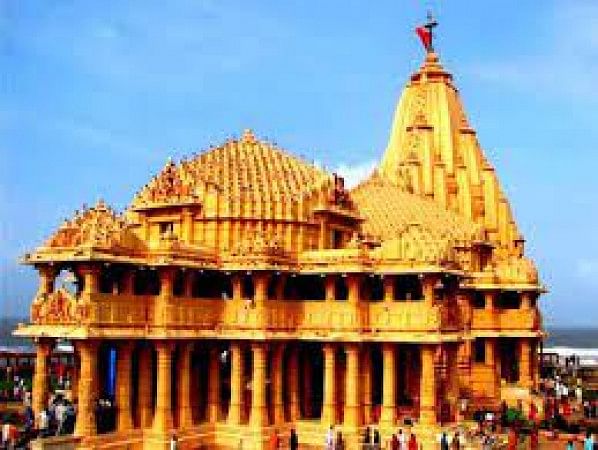
Jyothirlinga Temples Travel Guide
Jyothirlinga Temples, scattered across India, are considered the holiest abodes of Lord Shiva. These twelve temples hold immense religious significance for Hindus and are believed to be a manifestation of Lord Shiva himself. Each temple has a unique history and architectural beauty that attracts pilgrims and tourists from all over the world. The journey to these sacred sites offers a spiritual experience like no other, making it a must-visit for those seeking divine blessings and cultural enlightenment.Top Attractions in Jyothirlinga Temples
- Somnath Temple, Gujarat
- Mallikarjuna Temple, Andhra Pradesh
- Mahakaleshwar Temple, Madhya Pradesh
- Omkareshwar Temple, Madhya Pradesh
- Kedarnath Temple, Uttarakhand
- Bhimashankar Temple, Maharashtra
- Kashi Vishwanath Temple, Uttar Pradesh
- Trimbakeshwar Temple, Maharashtra
- Vaidyanath Temple, Jharkhand
- Nageshwar Temple, Gujarat
- Rameshwar Temple, Tamil Nadu
- Grishneshwar Temple, Maharashtra
Jyothirlinga Temples is Famous for
Known for being the holiest abodes of Lord Shiva, Jyothirlinga Temples are famous for their religious significance and architectural beauty.Top Attractions in Jyothirlinga Temples
- Experience the divine energy at each of the twelve Jyothirlinga Temples
- Explore the unique architecture and intricate carvings of the temples
- Participate in the religious ceremonies and rituals to immerse in the spiritual atmosphere
- Witness the devotion and faith of pilgrims from all walks of life
- Discover the cultural heritage and historical tales associated with each temple
What's Great about Travelling to Jyothirlinga Temples?
- Perfect for spiritual seekers and devotees of Lord Shiva
- Offers a cultural and historical journey through ancient India
- Opportunity to witness unique temple architecture and craftsmanship
- Provides a sense of peace and tranquility away from the hustle and bustle of city life
What's Not So Great about Travelling to Jyothirlinga Temples?
- May not be suitable for travelers seeking a party or nightlife scene
- Limited dining and accommodation options near some remote temple locations
- Requires respect for religious customs and traditions, which may not appeal to all travelers
Travel Tips for Jyothirlinga Temples
- Check the dress code and guidelines before visiting the temples
- Respect the religious sentiments of fellow pilgrims and devotees
- Plan your visit during the off-peak seasons to avoid crowds
- Carry necessary items such as water, sunscreen, and comfortable footwear
Important Jyothirlinga Temples trip information
- Ideal Duration: A week to visit all twelve temples
- Best Time to Visit: Winter months from October to March for pleasant weather
- Nearby Airports and Railway Stations: Varied depending on the temple location
FAQ's on Jyothirlinga Temples
Q1: What is the best time to visit Jyothirlinga Temples?
The best time to visit Jyothirlinga Temples is during the winter months from November to February when the weather is pleasant and suitable for sightseeing. Avoid the monsoon season from June to September as heavy rains can disrupt travel plans. The temples are also popular during festival seasons like Maha Shivaratri and Diwali, offering a vibrant cultural experience.
Q2: Do I need a visa to travel to Jyothirlinga Temples?
Visitors to Jyothirlinga Temples typically do not require a visa as it is a religious pilgrimage destination within India. However, international travelers should check with the Indian embassy or consulate in their country for specific requirements, especially if they plan to visit other parts of India before or after their pilgrimage.
Q3: What are the must-visit attractions in Jyothirlinga Temples?
The must-visit attractions in Jyothirlinga Temples include revered temples such as Somnath in Gujarat, Mallikarjuna in Andhra Pradesh, Mahakaleshwar in Madhya Pradesh, and many more spread across India. Each temple has its unique significance and architectural beauty, making it a spiritual journey worth experiencing for devotees and travelers alike.
Q4: Is Jyothirlinga Temples a safe place to travel?
Jyothirlinga Temples are considered safe for travelers, but like any other destination, it is advisable to take necessary precautions. Avoid isolated areas at night and be mindful of your belongings in crowded places. Respect local customs and traditions to ensure a smooth and enjoyable pilgrimage experience.
Q5: What is the local currency in Jyothirlinga Temples and can I use credit cards?
The local currency in India is the Indian Rupee (INR). ATMs are widely available in cities and towns near the temples for cash withdrawals. While some establishments may accept credit cards, it is advisable to carry cash for smaller purchases and transactions.
Q6: What is the local cuisine like in Jyothirlinga Temples?
The local cuisine around Jyothirlinga Temples offers a diverse range of flavors and dishes. From traditional vegetarian thalis to regional specialties like Gujarati, Andhra, and Maharashtrian cuisine, visitors can savor a variety of delicious meals. Don't miss trying local street food and sweets like jalebi, poha, and lassi during your visit.
Q7: What transportation options are available in Jyothirlinga Temples?
Transportation options in and around Jyothirlinga Temples include buses, trains, and private taxis for convenient travel between temple sites. Auto-rickshaws and cycle rickshaws are also available for short distances. For more flexibility, visitors can opt for car rentals or hire a guide to explore the temples comfortably.
Q8: Are there any cultural norms or etiquette I should be aware of when visiting Jyothirlinga Temples?
When visiting Jyothirlinga Temples, it is important to dress modestly and remove footwear before entering temple premises as a sign of respect. Avoid public displays of affection and follow temple rules and regulations. Seek permission before taking photographs, especially inside the temples. Embrace the spiritual atmosphere with humility and reverence towards the sacred sites.
Q9: I am a travel agent. How can I buy travel leads of Jyothirlinga Temples?
Register yourself as a travel agent at agents.tripclap.com and then you can buy travel leads to Jyothirlinga Temples once your account is approved. For more details contact our support team at +91-8069186564 or support@tripclap.com
